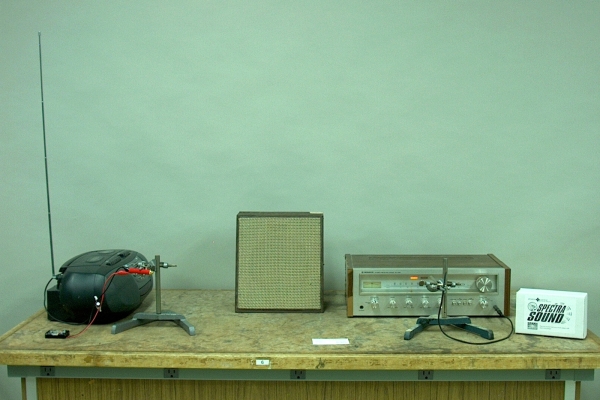

Thanks to Dr. Roger Freedman for suggesting this demonstration.
A laser beam transmits an audio signal from the “boom box” at left to the auxilliary input of the receiver at right, and you hear it through the speaker.
The red cylinder clamped to the stand at left in the photograph above is a keychain laser, which is connected via clip leads to an external battery pack with three AAA cells. In parallel with the battery pack is connected a 1000-μF capacitor in series with the end of an audio cable that has a miniature stereo phone plug at the other end. When this is plugged into the headphone jack of the boom box, the audio signal now combined with the DC voltage from the battery pack causes fluctuations in the intensity of the laser beam; it is a simple way of amplitude modulating the beam. The laser shines on a solar cell, clamped to the stand at right, which is connected to an audio cable that has a miniature stereo phone plug at the other end. This is plugged into the auxillary input of the receiver at right in the photograph. Whereas the laser beam by itself would produce a fixed DC voltage across the solar cell, the amplitude-modulated beam produces a fluctuating voltage whose fluctuations correspond to the audio signal from the boom box. The receiver amplifies this signal and plays it through the speaker.
This demonstration illustrates the basic mechanism by which many communications systems operate. Typically, the signal to be transmitted modulates the output of either a laser diode or an LED, either by modulating the current flowing through it, or by changing the optical properties of a device through which the emitted light travels. The modulated light is sent through an optical fiber, at the other end of which is a light-sensitive device such as a photodiode or phototransistor, whose conductance changes with the modulated light, thus allowing the signal to be reproduced. It is also possible to send signals via a modulated laser beam sent through air, as this demonstration does, or through space, and at least one research group is working on a method to do this.
The American Physical Society created the kit containing the keychain laser, solar cell and associated parts, and sold it under the name “Spectra Sound,” as you can see from the box at right in the photograph. This was part of Laserfest, the yearlong celebration of the 50th anniversary of the first working laser, which took place in 2010.